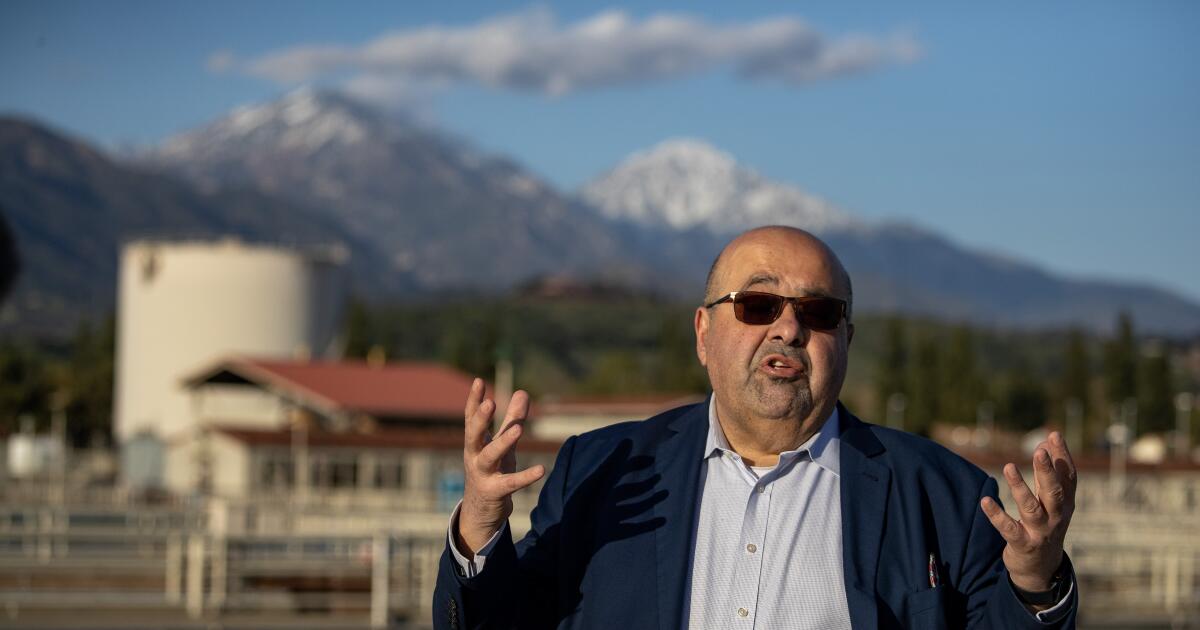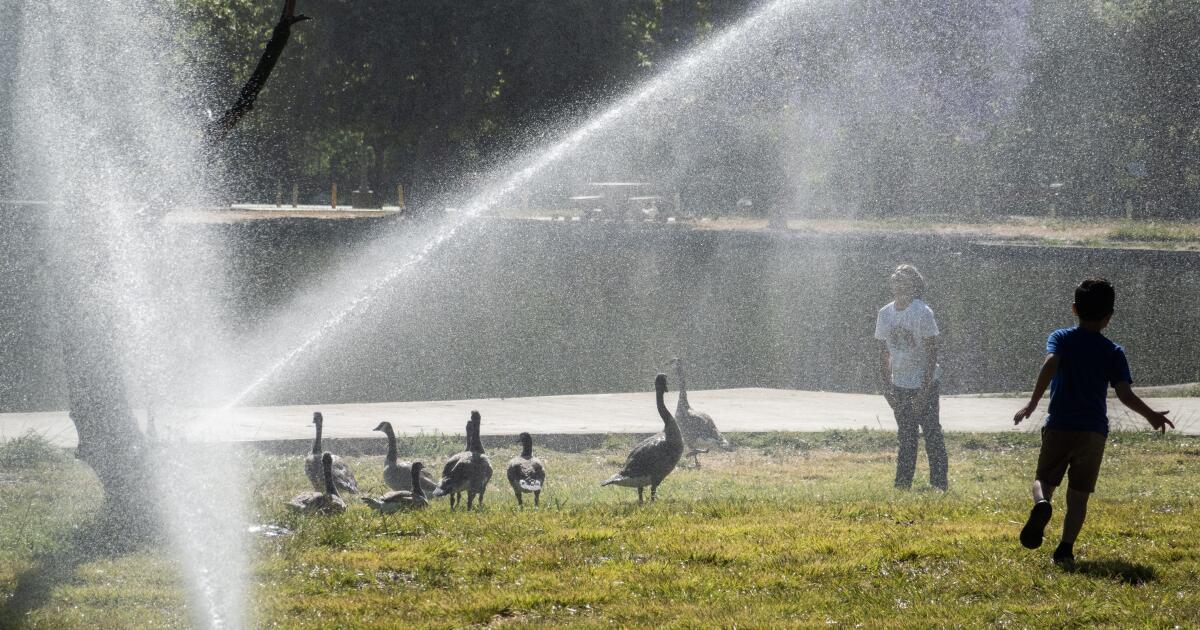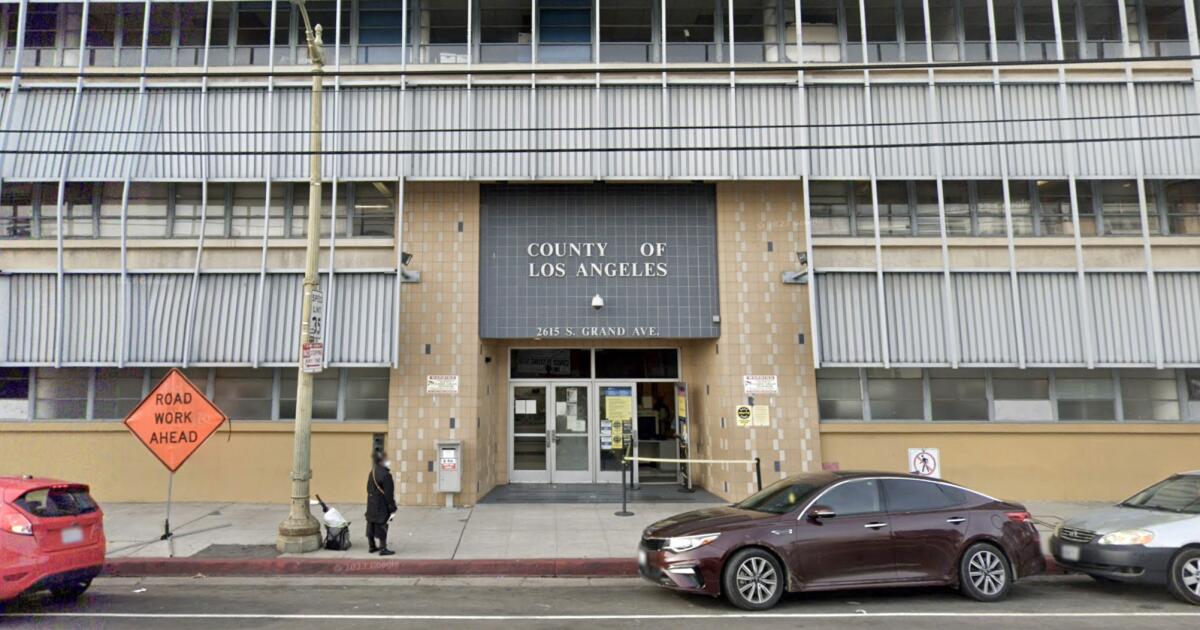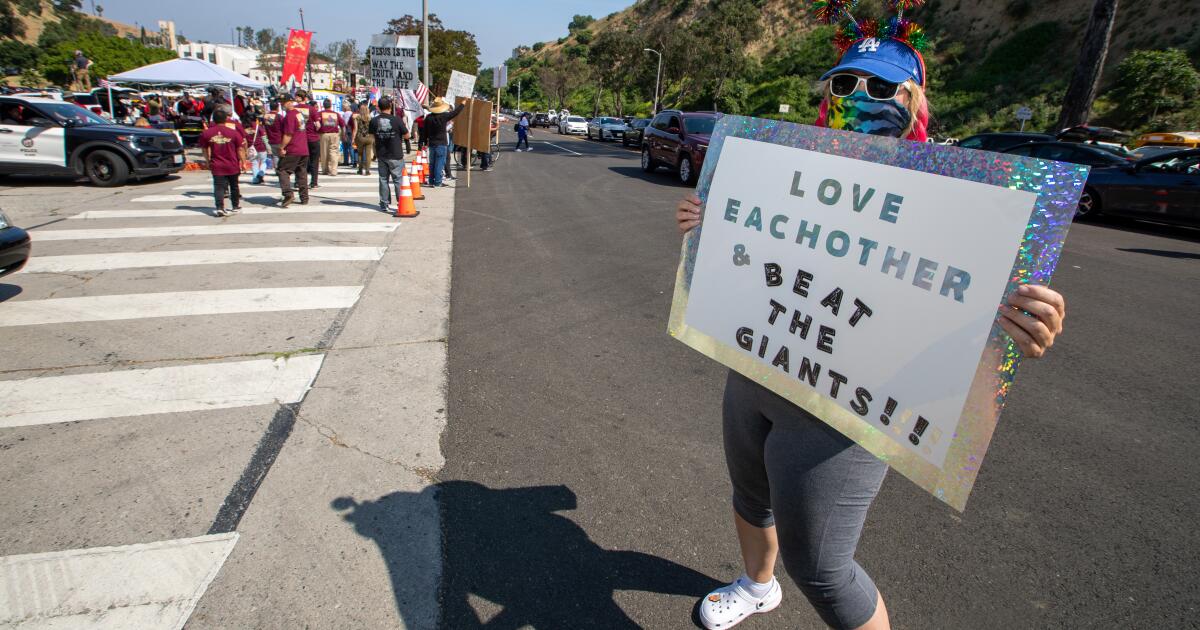World News
Despite investigation, leader of water agency says agenda unchanged

In the three years that Adel Hagekhalil has led California’s largest urban water supplier, the general manager has sought to focus on adaptation to climate change — in part by reducing reliance on water supplies from distant sources and investing in local water supplies.
His efforts to help shift priorities at the Metropolitan Water District of Southern California, which has traditionally focused largely on delivering imported water to the region, have won praise among environmental advocates who hope to reduce dependence on supplies from the Colorado River and Northern California.
However, now that Hagekhalil is under investigation for harassment allegations and has been placed on leave by the MWD board, some of his supporters say they’re concerned that his sidelining might interfere with the policies he has helped advance.
“I would hope this doesn’t mean that we undo the progress that’s been made since Adel came in,” said Conner Everts, executive director of the Southern California Watershed Alliance, who has supported Hagekhalil’s policies.
The accusations against Hagekhalil surfaced Thursday while he was traveling in Singapore for a water conference.
Chief Financial Officer Katano Kasaine made the allegations in a confidential letter to the board, which was leaked to the media. She said Hagekhalil has harassed, demeaned and sidelined her and created a hostile work environment.
Hagekhalil denied the accusations, saying he has always treated the staff with respect and professionalism, and that the claims amount to “disagreements on management decisions.”
The MWD board voted to place Hagekhalil on administrative leave for 90 days while Kasaine’s complaint and other allegations are investigated. In his place, the board temporarily appointed assistant general manager Deven Upadhyay, who has been at the agency for 29 years, as interim general manager.
Everts has for more than three decades been advocating for Southern California to reduce reliance on imported water supplies by boosting local supplies. He said he has been pleased to see Hagekhalil and MWD moving forward with plans for the country’s largest wastewater recycling facility in Carson, and working to develop a plan for adapting to climate change.
Everts said he hopes that whatever results emerge from the investigations, the agency doesn’t revert to an outmoded focus on imported water that he believes some “old guard” leaders of MWD still favor.
Everts, like many others who spoke at Thursday’s board meeting, said the accusations demand a fair and impartial investigation.
“Hopefully, Adel comes back and continues to lead in this direction. And if not, whoever would step in would do that,” Everts said. “Does the culture change of the agency continue to progress? That’s my question.”
MWD is the nation’s largest wholesale supplier of drinking water, serving cities and agencies that supply 19 million people across Southern California.
MWD Board Chair Adán Ortega Jr. said that while the board made “difficult decisions” regarding the allegations against Hagekhalil, “we maintain our commitment to the policies and direction of this organization.”
Ortega said he doesn’t expect any change in the district’s “current policy course.”
“Our task at hand is tackling climate change,” Ortega said in an interview with The Times. “Anybody that would challenge that is up against a pretty embedded policy framework for tackling climate change.”
Ortega was involved in selecting Hagekhalil, who previously worked for the city of Los Angeles and who was hired after a bitter struggle among board members in 2021. Ortega said his priorities as board chair have been the same priorities that Hagkhalil has been pursuing.
As for the accusations against Hagekhalil, Ortega said he was upset that someone leaked the confidential letter.
“I believe that whoever leaked it was trying to box in the board. But we’re not going to let them, and I don’t think it worked,” Ortega said.
He said all the initiatives that Hagekhalil was working on will continue under Upadhyay while the matters are investigated.
“The board drives the agenda,” he said. “I think the board has been united on things that Adel and I have both shared.”
Hagekhalil has led the agency at a time of major initiatives, including negotiations aimed at addressing water shortages on the Colorado River, plans for building the water recycling plant in Carson, and the MWD board’s consideration of Gov. Gavin Newsom’s plan to build a $20-billion water tunnel in the Sacramento-San Joaquin River Delta.
Some of Hagekhalil’s supporters questioned why the matter was brought to the board while he was traveling, and suggested the public airing of grievances appeared to be aimed at pushing aside a leading advocate for transforming the district’s focus.
But Ortega said any speculation that placing Hagekhalil on leave might derail the MWD’s current policy agenda is unfounded.
“The board is fully organized in support of that agenda,” Ortega said. “So I don’t feel any nervousness or doubt about our continued policy direction.”
“It’s a mistake to think that the fate of our policy agenda rests on one person,” he added. “Nothing is changing in terms of the board’s organization or the items that we’re considering in future months, or the composition of the committees. All of that is intact. And so nothing changes.”
Still, some environmental advocates have said they’re concerned about a potential link between the surfacing of allegations against Hagekhalil and efforts by some within the agency to push for the proposed Delta Conveyance Project, a 45-mile tunnel that would create a second route to draw water from the Sacramento River into the aqueducts of the State Water Project. They pointed out that Kasaine currently serves as treasurer of the Delta Conveyance Design and Construction Authority, the entity that was created to finance the tunnel project.
“I think it is a calculated ambush that is designed to get the tunnel approved, over the objections of other members of the Metropolitan board,” said Patricia Schifferle, director of Pacific Advocates, an environmental consulting firm.
During an MWD committee meeting on Monday, supporters and opponents of the proposed tunnel debated the costs and benefits of the project.
Karla Nemeth, director of the State Department of Water Resources, told board members that the project is essential to improving the reliability of water supplies in the face of climate change, sea-level rise and a major earthquake.
Other supporters made similar arguments, while opponents argued that building the tunnel would harm the delta’s deteriorating ecosystem and would be more expensive than other water-supply alternatives.
The costs would be paid for by urban and agricultural water districts that decide to participate. The state recently released a cost-benefit analysis that is intended to provide information for local water agencies to consider.
The MWD would receive a large share of the water, and the board’s eventual decision on whether to participate is expected to be pivotal in determining whether the state’s plan goes forward.
The MWD board in 2020 agreed to contribute $160.8 million toward planning and pre-construction costs. District officials say the board could consider whether to provide additional funding for planning and pre-construction costs at the end of this year, and it will likely be several years before there is a decision on long-term financial participation.
When the state’s cost-benefit analysis was released last month, Hagekhalil said: “The questions are, how can this project be implemented, what kind of assurances can we have in the resilience it provides to the Delta and our water supply future, and at what price?”
Leaders of several environmental groups said they were disappointed to see Hagekhalil placed on administrative leave before the accusations against him have been investigated.
“It is critically important and appropriate for MWD to take these allegations seriously and we applaud the agency’s decision to investigate the claims made, so that the board can have an accurate understanding of what has been happening among the organization’s senior leadership,” said Bruce Reznik, executive director of the group LA Waterkeeper. “That said, the public needs more information to ensure the complete independence of this review.”
He said any action against Hagekhalil should have come after an independent investigation.
Reznik called Hagekhalil a “visionary, inclusive and transparent leader” who is helping the agency reform its approach to adapt to the effects of climate change.
“He has been vocal about his vision and plans to transform the agency,” Reznik said. “That focus must continue at MWD.”
World News
The toll of extreme heat is rising in California

As California heads into a dangerous holiday heat wave that will blanket millions of residents in triple-digit temperatures, state and federal officials are vowing to do more to address the worsening threat — and the rising costs — of extreme heat.
On Tuesday, the U.S. Department of Labor’s Occupational Safety and Health Administration, or OSHA, announced that it will advance a proposed rule to protect indoor and outdoor workers from high temperatures at the national level. If finalized, the regulations would establish temperature-based standards for an estimated 35 million workers in places such as warehouses, kitchens, farms and construction sites.
The proposal, which has been in the works since 2021, would apply to workplaces where the heat index regularly rises above 80 degrees, according to senior administration officials. It would follow similar moves from California, which became the first state in the nation to establish permanent heat protections for outdoor workers in 2006 and approved heat regulations for indoor workers just last month.
Officials said such rules are needed as extreme heat claims more lives and as the nation grapples with more frequent and severe weather events fueled by climate change. Last year, the U.S. saw a record 28 disasters that exceeded $1 billion in losses, which caused more than $90 billion in aggregate damage.
At the same time, California’s Department of Insurance this week released a first-of-its kind analysis revealing $7.7 billion in insurance losses tied to extreme heat events over the last decade. The report quantifies the uninsured and insured costs of seven recent extreme heat events in the state and highlights the need for adaptive strategies.
It joins a growing body of evidence about extreme heat’s toll — from mounting heat-related illnesses and fatalities to biodiversity impacts, economic effects, agricultural losses and infrastructure damage. Heat has contributed to more deaths over the last 30 years than hurricanes, floods and tornadoes combined, making it the deadliest of all U.S. climate hazards, according to the National Weather Service. Last year was the planet’s hottest year ever recorded.
“Extreme heat is a silent, escalating disaster that threatens our health, economy, and way of life in California,” read a statement from Insurance Commissioner Ricardo Lara. “This report brings to light the staggering hidden costs of extreme heat events, underscoring the urgency of our efforts to create a groundbreaking heat wave ranking and early warning system statewide. We must prioritize resilience-building efforts and innovative insurance solutions to safeguard our state against the growing impacts and financial risks of extreme heat.”
Indeed, experts have for years been pushing for more stringent surveillance of heat’s toll, with a 2021 Los Angeles Times investigation revealing that extreme heat deaths are chronically undercounted in the state. Following that investigation, Gov. Gavin Newsom signed into law a bill to create a heat wave ranking system similar to those used for hurricanes. The system is slated to be in place by Jan. 1, 2025.
Newsom also in recent years launched an extreme heat awareness campaign, urban greening programs and other efforts to help residents prepare for and adapt to worsening heat; however some of those programs received cuts amid this year’s budget deficit.
Though the $7.7 billion cost associated with heat events is substantial, the Department of Insurance estimated that the true toll is likely higher. While some kinds of insurance do cover costs connected to extreme heat — such as health coverage, workers’ compensation insurance and crop insurance — there are gaps that will require new mechanisms and investments, the agency said. The state is currently facing a separate insurance crisis related to worsening wildfires.
Other costs associated with heat include labor productivity losses, which ranged from $7.7 million to $210 million per event, according to the report. Infrastructure repair costs due to heat-related damage ranged from $3.8 million to $35 million per event, predominantly affecting roads and rails, while power outages during heat waves resulted in substantial economic impacts up to $230 million.
One of the heat events covered in the report — a prolonged heat wave in September 2022 — pushed California’s power grid to the brink and prompted an emergency text message from the state’s energy operators asking residents to conserve power, narrowly avoiding a blackout.
That same heat wave was later determined to have killed 395 Californians, according to state health officials, who also reported that its worst affects were among Latinos and working-age people between ages 25 and 64.
The Department of Insurance’s report similarly underscored the ways in which extreme heat disproportionately affects communities of color, low-income communities and vulnerable populations such as seniors and children.
Jonathan Parfrey, executive director of Climate Resolve, said the report’s admittedly conservative estimates are “nonetheless staggering.”
“A hot day is not just an inconvenience — for hundreds of thousands of Californians, extreme heat is a matter of life and death,” Parfrey said, adding that the losses in labor productivity alone should be a wake-up call to industry and policymakers. “The lesson is this: investing in cooling solutions today will save money and lives tomorrow.”
But strengthening workplace protections will also help save lives, White House officials said.
OSHA’s proposed rule, which will be sent to the federal register and made available for public comments, would require workplaces to establish heat illness and injury prevention plans that are evaluated at least once a year; to provide workers with access to drinking water and cool-down areas and to respond to symptoms of heat illness and emergencies, among other measures.
Additional protections would be triggered at temperatures of 90 degrees or hotter, including mandatory rest breaks and symptom monitoring.
States such as California, which already have workplace heat regulations in place, would have to have meet the minimum federal requirements but can go further, officials said. States such as Florida and Texas — which have passed laws blocking cities or employers from establishing heat rules — would also have to comply with the federal rule or face significant penalties for violations.
The proposed rule joins other efforts from the Biden Administration to address worsening heat and climate hazards, including a new heat risk tool from the National Weather Service; cooling assistance programs for low-income households and expanded investments in trees and green spaces.
The Federal Emergency Management Agency on Tuesday also announced that it will make available $1 billion in funding for its Building Resilient Infrastructure and Communities program to help communities reduce their risk from disasters and natural hazards, including extreme heat, wildfires, droughts, hurricanes, earthquakes and floods.
The funding includes 656 projects across the nation, including considerable investments in disadvantaged communities, agency officials said.
However, FEMA continues to face pressure from environmental groups and labor organizations urging it broaden its definition of “major disasters” to include extreme heat, which advocates say would unlock additional avenues of funding during heat waves and help states and communities better prepare for rising temperatures.
Already this year, FEMA and other federal agencies have responded to more than a dozen disasters, including devastating wildfires in New Mexico and historic flooding in Iowa and Minnesota, officials said.
They are currently monitoring Hurricane Beryl — which became the first hurricane on record to reach Category 4 in the month of June — as well as the record-breaking heat slated to smother much of the country this week.
But heat waves continue to pose unique dangers, with the average length of the heat wave season now 46 days longer than it was in the 1960s, according to a new report from the U.S. Environmental Protection Agency.
In California, officials warned that the incoming heat wave could also lead to wildfires as soaring temperatures coincide with fireworks, barbecues and other Fourth of July-related activities. State officials are warning that power shutoffs are possible in some Northern California counties, where temperatures could soar as high as 110 degrees.
Portions of the Central Valley and the Antelope Valley may also climb to 110 degrees, while the Coachella Valley could bake at 121 degrees and Death Valley at 125 degrees.
The heat wave is expected to linger for days, forecasters said — with some parts of the Golden State not likely to see relief until at least the start of next week.
World News
China’s BYD posts 21% jump in quarterly EV sales, closes gap with Tesla
BEIJING (Reuters) – China’s BYD (BYDDY) posted a 21% rise in second-quarter electric vehicle sales, closing the gap with Tesla (TSLA) after handing back the world’s top EV vendor title to the U.S. rival in the first quarter.
BYD sold 426,039 EVs in the April-June quarter, according to Reuters’ calculations based on its monthly sales reports. That’s around 12,000 vehicles fewer than Tesla’s vehicle deliveries estimated for the second quarter.


Tesla is expected to report a 6% drop in April-June quarter vehicle deliveries on Tuesday, the first time the U.S. firm is set to post two straight quarters of decline, as it deals with stiff competition in China and slow demand due to a lack of affordable new models.
The company may again cede its EV championship to BYD if the actual results turn out to be softer than estimated, with Barclays predicting an 11% drop in second-quarter deliveries, Tesla’s biggest ever.
Tesla has hit a speed bump after years of rapid growth that helped make it the world’s most valuable automaker. It warned in January that deliveries growth in 2024 would be “notably lower” as a boost from months-long price cuts wanes.
The EV maker has cut output of its best-selling Model Y electric car by a double-digit percentage number at its Shanghai plant since March to address weakening demand for its aged models in China, its second-largest market after the United States, Reuters reported in May.
By comparison, its top Chinese competitor BYD maintained steady growth in EV sales, while EV upstarts such as Nio reported stellar growth last quarter. NIO’s vehicle deliveries in the second quarter more than doubled to 57,300 units.
Price cuts and a growing shift in consumer demand to EVs and hybrids from gasoline-powered vehicles are the main reasons behind Chinese EV makers’ strong sales in recent months, said Cui Dongshu, secretary general, China Passenger Car Association (CPCA).
Sales of new energy vehicles including EVs and plug-in hybrids in China made up 46.7% of total car sales in May, a fresh monthly high, as per CPCA data.
(Reporting by Qiaoyi Li, Zhang Yan and Kevin Krolicki; Editing by Miyoung Kim and Sherry Jacob-Phillips)
World News
Biden slams SCOTUS presidential immunity ruling, ignores questions about dropping out

President Biden slammed the Supreme Court’s ruling on presidential immunity in Trump v. United States, saying it means there are virtually no limits on what a president can do, in a speedy address Monday evening.
The president spoke for less than five minutes – four minutes and 40 seconds to be exact – before turning his back to the press and walking away.
“This is a fundamentally new principle, and it’s a dangerous precedent, because the power of the office will no longer be constrained by the law, even including the Supreme Court of the United States,” Biden said.
The Supreme Court ruled that a former president has substantial immunity from prosecution for official acts committed while in office, but not for unofficial acts.
TRUMP IMMUNITY CASE: SUPREME COURT RULES EX-PRESIDENTS HAVE SUBSTANTIAL PROTECTION FROM PROSECUTION

Trump and Biden squared off in their high-stakes 2024 election debate rematch last week. (Justin Sullivan/Getty Images, left, )
In a 6-3 decision, the Court sent the matter back down to a lower court, as the justices did not apply the ruling to whether or not former President Trump is immune from prosecution regarding actions related to efforts to overturn the results of the 2020 election.
Biden continued his address, saying that the American people must decide whether Donald Trump’s assault on democracy on January 6th makes him “unfit” for public office and the highest office in the land.
“The American people must decide if Trump’s embrace of violence to preserve his power is acceptable. Perhaps most importantly, the American people must decide if they want to entrust the presidency to Donald Trump once again. Now knowing, he’ll be even more emboldened to do whatever he pleases, whenever he wants to do it,” Biden said.
Biden also spoke about the character of the nation’s first president, George Washington, and how he believed power was limited, not absolute.
Biden wrapped his speech and dodged questions from reporters as he left abruptly.
Reporters shouted questions at Biden, asking him if he plans to drop out of the presidential race following his debate with Trump.

US President Joe Biden speaks during a Memorial Day address at Arlington National Cemetery in Arlington, Virginia, US, on Monday, May 27, 2024. (Bonnie Cash/UPI/Bloomberg via Getty Images)
Biden has not taken questions from the press and has used teleprompters at his events, including a fundraiser in the Hamptons, following his disastrous debate performance against Trump last week.
“Today’s Historic Decision by the Supreme Court should end all of Crooked Joe Biden’s Witch Hunts against me, including the New York Hoaxes – The Manhattan SCAM cooked up by Soros backed D.A., Alvin Bragg, Racist New York Attorney General Tish James’ shameless ATTACK on the amazing business that I have built, and the FAKE Bergdorf’s “case.” PROUD TO BE AN AMERICAN!,” Trump wrote in a post on his social media site Truth Social.
BIDEN CAMP DISMISSES TRUMP IMMUNITY RULING: ‘DOESN’T CHANGE THE FACTS’

Trump pleaded not guilty to all charges and argued he should be immune from prosecution from official acts done as president of the U.S. (Michael M. Santiago/Getty Images)
The former president was charged in August 2023 by Special Counsel Jack Smith with conspiring to overturn the results of his election loss to President Biden in the run-up to the Jan. 6, 2021, riot at the U.S. Capitol.
Trump has denied doing anything wrong and has said this prosecution and three others are politically motivated to try to keep him from returning to the White House.
Trump shared his reaction to the Supreme Court’s ruling on his presidential immunity case, saying it’s a “big win for our constitution and democracy,” according to his Truth Social page.
CLICK HERE TO GET THE FOX NEWS APP
“THE SUPREME COURT DECISION IS A MUCH MORE POWERFUL ONE THAN SOME HAD EXPECTED IT TO BE. IT IS BRILLIANTLY WRITTEN AND WISE, AND CLEARS THE STENCH FROM THE BIDEN TRIALS AND HOAXES, ALL OF THEM, THAT HAVE BEEN USED AS AN UNFAIR ATTACK ON CROOKED JOE BIDEN’S POLITICAL OPPONENT, ME. MANY OF THESE FAKE CASES WILL NOW DISAPPEAR, OR WITHER INTO OBSCURITY. GOD BLESS AMERICA!” Trump posted.
Fox News Digital’s Brooke Singman and Brianna Herlihy contributed to this report.
-

 African History5 years ago
African History5 years agoA Closer Look: Afro-Mexicans 🇲🇽
-

 African History5 months ago
African History5 months agoBlack History Facts I had to Learn on My Own pt.6 📜
-

 African History5 years ago
African History5 years agoA Closer Look: Afro-Mexicans 🇲🇽
-

 African History1 year ago
African History1 year agoMajor African Tribes taken away during the Atlantic Slave Trade🌍 #slavetrade #africanamericanhistory
-

 African History1 year ago
African History1 year agoCameroon 🇨🇲 World Cup History (1962-2022) #football #realmadrid #shorts
-

 African History1 year ago
African History1 year agoPROOF AFRICAN AMERICANS AIN'T FROM AFRICA DOCUMENTED EVIDENCE
-

 African History5 months ago
African History5 months agoBlack History Inventors: Mary Kenner 🩸
-

 African History5 months ago
African History5 months agoMr Incredible Becoming Canny/Uncanny Mapping (You live in Paraguay 🇵🇾)





























